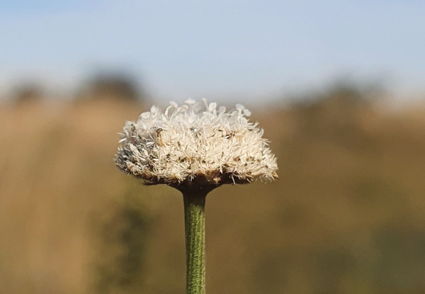Abstract
Paepalanthus balansae, P. lundii, and P. scholiophyllus are morphologically related species growing in swampy areas of central South America, and are frequently misidentified in collections worldwide. We discuss here new and relevant morphological data to elucidate the circumscription of these species. Paepalanthus balansae is maintained as a distinct species following its current circumscription, while the wide morphological variation of P. scholiophyllus is understood here within a broader P. lundii concept and treated as synonymous. We report herein the presence of short lateral branches covered by a few bracts and subtending a single or a few inflorescences for the first time in P. lundii and P. balansae. This character, along with floral details and the scarce molecular data available, reinforce that these species are closely related to Actinocephalus. We also provide nomenclatural adjustments for the types and infrageneric names related to these taxa, along with a distribution map and images.
References
Andrino, C.O., Sano, P.T., Inglis, P.W., Hensold, N., Costa, F.N. & Simon, M.F. (2021) Phylogenetics of Paepalanthus (Eriocaulaceae), a diverse Neotropical monocot lineage. Botanical Journal of the Linnean Society 195: 34–52. https://doi.org/10.1093/botlinnean/boaa070
Andrino, C.O., Costa, F.N., Simon, M.F., Missagia, R.V. & Sano, P.T. (2023) Eriocaulaceae: a new classification system based on morphological evolution and molecular evidence. Taxon. [published online] https://doi.org/10.1002/tax.12915
Bongard, M. (1831) Essai monographique sur les espèces d’Ériocaulon du Brésil. Mémoirs Academie Imperial Sciences St-Pétersbourg, Série 6, Sciences Mathematiquè 1: 601–655.
Chodat, R. & Hassler, E. (1903) Plante Hasslerianae, soit énumération des plantes recoltées au Paraguay par le dr. Emile Hassler. Bulletin de l‘Herbier Boissier ser. 2, vol. 3. Geneva, pp. 255–256.
Costa, F.N. & Sano, P.T. (2013) New circumscription of the endemic Brazilian genus Actinocephalus (Eriocaulaceae). Novon 22: 281–287. https://doi.org/10.3417/2011001
Del-Claro, K, Rodriguez-Morales, D., Calixto, E.S., Martins, A.S. & Torezan-Silingardi, H.M. (2019) Ant pollination of Paepalanthus lundii (Eriocaulaceae) in Brazilian savanna. Annals of Botany 123: 1159–1165. https://doi.org/10.1093/aob/mcz021
Echternacht, L., Sano, P.T. & Dubuisson, J.-Y. (2015) Taxonomic study of Comanthera subg. Thysanocephalus. Systematic Botany 40: 136–150. https://doi.org/10.1600/036364415X68643
Giulietti, A.M. & Hensold, N. (1990) Padrões de distribuição geográfica dos gêneros de Eriocaulaceae. Acta Botanica Brasilica 4: 133–159. https://doi.org/10.1590/S0102−33061990000100010
Giulietti, A.M. & Hensold, N. (1991) Nomenclatural changes and range extension in Leiotrhix flavescens (Bong.) Ruhland (Eriocaulaceae). Novon 1: 45–49. https://doi.org/10.2307/3391718
Giulietti, A.M., Andrade, M.J.G, Scatena, V.L., Trovó, M., Coan, A.I., Sano, P.T., Santos, F.A.R, Borges, R.L.B. & van den Berg, C. (2012) Molecular phylogeny, morphology and their implications for the taxonomy of Eriocaulaceae. Rodriguésia 63: 1−19. https://doi.org/10.1590/S2175-78602012000100001
Giulietti, A.M., Trovó, M. & Sano, P.T. (2018) Eriocaulaceae. In: Ramella, L. (ed.) Flora del Paraguay. Editions des Conservatoire et Jardin botaniques, Geneva, pp. 1–35.
Herzog, T. (1924) Neue südamerikanische Eriocaulaceae. Feddes Repertertorium 20: 82–88. https://doi.org/10.1002/fedr.19240200603
Koernicke, F. (1863) Eriocaulaceae. In: Martius, C.F.P. & Eichler, A.W. (eds.) Flora brasiliensis 3 (1). Royal Typography, Munich, pp. 273–508. https://doi.org/10.5962/bhl.title.454
Kuntze, O. (1891) Eriocaulaceae. In: Revisio Generum Plantarum 1. Arthur Felix, Leipzig, pp. 745–746. https://doi.org/10.5962/bhl.title.327
Martius, K.F.P. (1834) Eriocaulaceae. Anales des Sciences Naturelles, Botanique 2: 25–43.
McNeill, J. (2014) Holotype specimens and type citations: General issues. Taxon 63: 1112–1113. https://doi.org/10.12705/635.7
Moldenke, H.N. (1953) Additional notes on the Eriocaulaceae IX. Phytologia 4: 200−208.
Moldenke, H.N. (1962) Notes on new and noteworthy plants XXX. Phytologia 8: 159−164.
Moldenke, H.N. (1970) Additional notes on the Eriocaulaceae XXXIV. Phytologia 20: 339−368.
Moldenke, H.N. (1976) Additional notes on the Eriocaulaceae LX. Phytologia 33: 130−153.
Moldenke, H.N. (1977) Notes on new and noteworthy plants XCIX. Phytologia 36: 49−53. https://doi.org/10.5962/bhl.part.21677
Moldenke, H.N. (1982) Notes on new and noteworthy plants CLVIII. Phytologia 51: 244−245.
Parra, L.R., Giulietti, A.M., Andrade, M.J.G. & van den Berg, C. (2010) Reestablishment and a new circumscription of Comanthera (Eriocaulaceae). Taxon 59: 1135–1146. https://doi.org/10.1002/tax.594013
Prado, J., Hirai, R.Y. & Moran, R.C. (2015) Proposals concerning inadvertent lectotypifications (and neotypifications). Taxon 64: 651. https://doi.org/10.12705/643.29
Radford, A.E., Dickson, W.C., Massey, J.R. & Bell, C.R. (1974) Vascular plant systematics. Harper & Row Pub, New York, 891 pp.
Ruhland, W. (1903) Eriocaulaceae. In: Engler, A. (ed.) Das Pflanzenreich. Regni vegetabilis conspectus 4 heft 30. Wilhelm Engelmann, Leipzig, pp. 1–294.
Sano, P.T. (2004) Actinocephalus (Körn.) Sano (Paepalanthus sect. Actinocephalus), a new genus of Eriocaulaceae, and other taxonomic and nomenclatural changes involving Paepalanthus Mart. Taxon 53 (1): 99–107. https://doi.org/10.2307/4135493
Silveira, A. (1908) Flora e serras mineiras. Imprensa Official. Belo Horizonte, 79 pp.
Silveira, A.A. (1928) Floralia montium, vol. 1. Imprensa Official, Belo Horizonte, 262 pp.
Stuessy, T.F. (1990) Plant taxonomy, the systematic evaluation of comparative data. Columbia University, Press New York, 562 pp.
Stützel, T. & Trovó, M. (2013) Inflorescences in Eriocaulaceae: taxonomic relevance and practical implications. Annals of Botany 112: 1505–1522. https://doi.org/10.1093/aob/mct234
Thiers, B. (continuously updated) Index Herbariorum: A global directory of public herbaria and associated staff. New York Botanical Garden’s Virtual Herbarium. Available from: http://sweetgum.nybg.org/ih/ (accessed: 15 June 2022).
Trovó, M. (2018) Tackling the Paepalanthus elongatus complex (Eriocaulaceae) in central Brazil: nomenclatural changes and description of a new species from Goiás. Phytotaxa 367: 13–24. https://doi.org/10.11646/phytotaxa.367.1.2
Trovó, M. & Sano, P.T. (2010) Nomenclatural and taxonomic changes in Paepalanthus (Eriocaulaceae) from São Paulo and Minas Gerais, Brazil. Kew Bulletin 65: 275–278. https://doi.org/10.1007/s12225-010-9207-2
Trovó, M., Winkworth, R. & Sano, P.T. (2008) Morphology and environment: geographic distribution, ecological disjunction, and morphological variation in Actinocephalus polyanthus (Bong.) Sano (Eriocaulaceae). Feddes Repertorium 119: 634–643. https://doi.org/10.1002/fedr.200811189
Turland, N.J., Wiersema, J.H., Barrie, F.R., Greuter, W., Hawksworth, D.L., Herendeen, P.S., Knapp, S., Kusber, W.H., Li, D.Z., Marhold, K., May, T.W., McNeill, J., Monro, A.M., Prado, J., Price, M.J. & Smith, G.F. (Eds.) (2018) International Code of Nomenclature for algae, fungi, and plants (Shenzhen Code) adopted by the Nineteenth International Botanical Congress Shenzhen, China, July 2017. Regnum Vegetabile 159. Koeltz Botanical Books, Glashütten, 254 pp. https://doi.org/10.12705/Code.2018
Vasconcelos, T.N.C., Alcantara, S., Andrino, C.O., Forest, F., Reginato, M., Simon, M.F., Pirani, J.R. (2020) Fast diversification through a mosaic of evolutionary histories characterizes the endemic flora of ancient Neotropical mountains. Proc. R. Soc. B 287: 20192933. https://doi.org/10.1098/rspb.2019.2933
Weberling, F. (1989) Morphology of flowers and inflorescences. Cambridge University Press, Cambridge, 423 pp.


